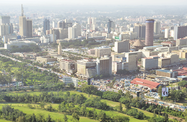Ongoing expansion in key sectors fuelled solid growth in Kenya in 2019, although rising debt continues to challenge economic performance.

In 2019 the economy was projected to have grown by 5.6%, according to a review released by the IMF in October, down on the previous year’s expansion of 6.3%.
This projection aligns broadly with the performance of the economy over the first three quarters of the year, in which, according to figures released by the Kenya National Bureau of Statistics, GDP expanded by 5.2% year-on-year (y-o-y).
In this period growth was driven by a 4.4% y-o-y expansion of agriculture – the country’s largest sector – followed by gains in information and communication (10%), construction (6.5%), finance and insurance (6.1%), and wholesale and retail trade (5.4%).
Inflation, which stood at 5.8% in December, remains within the Treasury’s target range of 5-7.5%, but was up from the year’s low of 3.8% in September.
The country’s rising debt is a pending challenge. Total public debt rose to KSh6trn ($59.4bn) over the course of 2019, equivalent to 62.3% of GDP, according to the World Bank, up sharply from 2012 levels of 38.2%.
This rise in recent years has seen debt breach the government’s recommended threshold of 50% of GDP, and comes as the Senate voted in November to raise the country’s debt ceiling to KSh9trn ($89.3bn), which the Treasury projects the country will hit by June 2024. Authorities also abandoned a limit pegged to GDP.
Meanwhile, the Nairobi Securities Exchange benchmark index has gained 74% since 2010, making it the best-performing stock exchange in sub-Saharan Africa over the period.
See also: The Report – Kenya 2018
Interest rate cap repealed
While figures for 2019 have been mixed, the decision to remove a cap on interest rates is expected to provide a boost to lending and overall economic growth moving forward.
In early November Parliament repealed the 4% cap placed on the lending rate for banks, which had been introduced in September 2016.
While the cap was intended to improve the affordability and availability of loans to the general public, it had unintended consequences, among them reducing credit given to the private sector.
The cap particularly affected micro-, small and medium-sized enterprises (MSME). Prior to its imposition, the MSME loan portfolio was growing at an annual rate of 15%, but this halved after 2016.
The decision to abolish the cap won plaudits from international institutions like the IMF, and is expected to bolster lending for entrepreneurial activity.
Reforms boost investment climate
The initiatives come at a time when Kenya’s attractiveness as a business destination has been increasing.
Ongoing business-friendly reforms have seen the country move up to 56th position out of 190 countries in the World Bank’s 2020 ease of doing business index, released in October 2019, up 80 places in the past five years.
Carole Kariuki, CEO of Kenya Private Sector Alliance, told OBG that “this has been a concerted effort between the private sector and the government. Our target is to be in the top 50 in the 2021 index”.
Meanwhile, Kenya was ranked third out of 66 countries in terms of their potential future trade growth in a September 2019 report released by Standard Chartered.
Coming in behind Côte d’Ivoire and India, Kenya was praised for recent upgrades to road and railway infrastructure – factors that have made it easier to move goods domestically and to its neighbours.
This positive sentiment has also translated into greater levels of foreign direct investment (FDI), which was expected to reach $2.9bn in 2019, considerably higher than the previous record of $1.6bn seen in 2018, accordingly to FDI Markets, a Financial Times data service.
“We have seen higher levels of FDI thanks to additional clarity on investment opportunities related to the Big Four Agenda, as well as stronger investment promotion campaigns and continued improvement in the overall investment environment,” Moses Ikaria, managing director of the Kenyan Investment Authority, told OBG.


